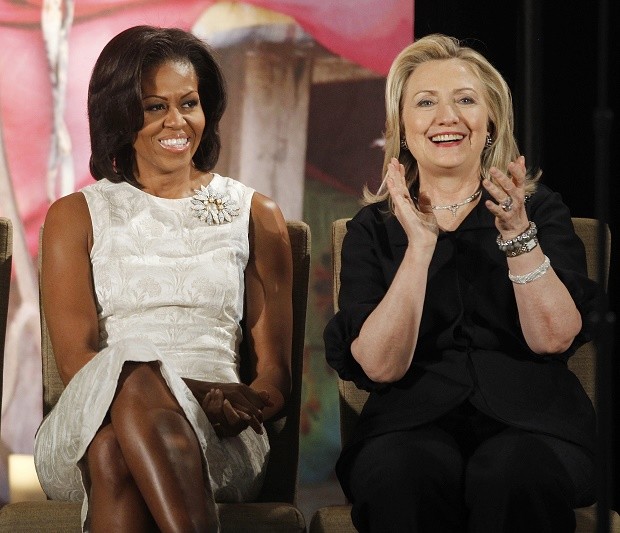Clinton and Obama: First ladies form political odd couple

In this March 8, 2012, file photo, then-Secretary of State Hillary Clinton and first lady Michelle Obama attend the 2012 International Women of Courage Awards at the State Department in Washington. Clinton and Obama are slated to campaign together for the first time at a rally in Winston-Salem, North Carolina on Oct. 27, 2016. The event will bring together two women who are a study in contrasts. Clinton is perhaps one of the least traditional first ladies in modern history, while Obama has fully embraced tradition. AP FILE PHOTO
WASHINGTON — When Hillary Clinton secured her place in the history as the first woman to win a major-party nomination for president, Democratic politicians around Washington marked the historic moment with barrage of statements, formal endorsements and public cheers.
One political figure, however, was notably silent: Michelle Obama.
The first lady let her husband speak for her during that moment in June, choosing instead to wait weeks to lend her voice to Clinton’s cause at the Democratic National Convention in what would become one of the most memorable moments in the campaign. It was the sort of careful choice that illustrated the gulf of differences between the current and former first ladies, women who have chartered very different paths through public life and are now locked in marriage of mutual interest.
When they campaign together for the first time Thursday, the event in Winston-Salem, North Carolina, will bring together one of the least traditional first ladies in modern history with one who has fully embraced tradition.
Clinton dove into policy, undertook a massive project and failed under a harsh spotlight. Mrs. Obama largely steered clear and enjoyed quieter, modest success. Both Ivy League-trained lawyers with their own careers, Clinton bridled under the stereotypes associated with the office, Mrs. Obama declared herself “mom-in-chief” (and let it be known she prefers the Mrs. title before her last name).
Article continues after this advertisementAnd when her time in the White House was ending, Clinton began plotting her return to Washington. Mrs. Obama hasn’t hid her readiness to leave.
Article continues after this advertisementAsked if Mrs. Obama would ever consider running for president herself, White House officials who rarely speak for the first lady don’t hesitate.
“No,” White House spokesman Josh Earnest said flatly.
That’s crushing news to the Democrats who have relished Mrs. Obama’s speeches in support of Clinton as high-points of the campaign cycle. Mrs. Obama’s passionate response to Trump’s vulgar comments about women has brought an emotional resonance to Clinton’s bid that the candidate, who rarely gets personal on the stump, doesn’t often deliver.
Mrs. Obama’s appearances have become a key part of Clinton’s effort to fire up women, particularly black women for whom she’s a model and a source of pride. (Clinton even quotes Mrs. Obama’s DNC speech on the stump: “When they go low, we go high.”) Mrs. Obama, meanwhile, has her own reasons for stumping for Clinton and campaigning against Republican Donald Trump.
“I think Mrs. Obama really wants to make sure her husband’s legacy is maintained and Mrs. Clinton is the way to get there,” said Myra Gutin, a professor at Rider University who has written about first ladies and women in politics.
READ: Michelle Obama delivers glowing endorsement of Clinton
The partnership has on one level made for a striking political odd couple.
As first lady, Mrs. Obama has largely dodged controversial issues. She’s stayed focused on her projects involving healthy eating, exercise, support for military families and education for girls — and not publicly expressed opinions on thornier subjects. She’s mastered the art of advocacy through popular culture, while, in recent years, all-but ignoring the possibility of policymaking through legislation. She’s cultivated a brand built on style, glamor and fashion.
It’s a tenure that bears little resemblance to her Democratic predecessor in the East Wing. Clinton came in promising, along with her husband, a new kind of partnership in charge at the White House. Hillary Clinton was a veteran of the feminist movement and ready to expand the office of first lady to suit her experience and passion for policy. She had an office in the West Wing, took over the health care overhaul effort and ultimately became a target of investigations and criticism alongside her husband.
It was a history Mrs. Obama and her aides sought to avoid. Asked to cite role models, Obama has named Eleanor Roosevelt and Jacqueline Kennedy. The Clintons and Obamas, of course, have a fraught history, one that includes both spouses. While Barack Obama and Hillary Clinton battled in 2008, Michelle Obama raised questions about her husband’s opponent, framing the choice between the two as “about character.”
Since then the women have publicly buried the hatchet. They’ve appeared at countless events together and heaped praised on each other’s work, although there’s little sign they’ve spent time one-on-one.
Comparing how first ladies use the office is especially tricky, historians note. Because the office comes with no set of constitutional duties, it is also a reflection of an individual’s style, personality, politics and times.
The differences between Clinton and Mrs. Obama’s tenures speak in some ways to the differences in their generations — Clinton representing the first wave of baby boomers eager to push boundaries, while Obama benefited from lessons learned, noted Carl Sferrazza Anthony, a historian at the National First Ladies Library.
“Beneath the surface they both brought a sense of rigor and structure and focus,” he said. “They were very objective oriented.”
Those objectives were clearly different, he said.
“I think Michelle Obama may end up being perhaps one of the most influential first ladies when it comes to influence on the American public, whereas Hillary has been one of the most important in terms of achievement in terms of policy.”/rga